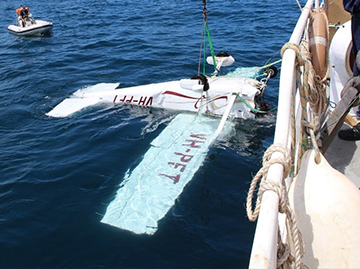A fatal Cessna 172S aircraft accident highlights the dangers of an aircraft stalling and then spinning while conducting turning manoeuvres, particularly at low heights.

On 29 December 2014, a Cessna 172S aircraft departed Cambridge Airport, Tasmania to photograph yachts participating in the 2014 Sydney Hobart race as they made their way around the southern coast of the Tasman Peninsula. On board the aircraft were the pilot and a photographer.
At about 1815 the aircraft commenced low-level photographic runs on yachts to the east of Cape Raoul. Shortly after completing a run on one yacht at a height of about 50 ft, the aircraft entered a steep turn. The aircraft had almost completed a 180° turn when the upper (right) wing dropped sharply while the aircraft’s nose pitched down to almost vertical. The aircraft impacted the water’s surface in an almost vertical nose down attitude with wings about level. Both aircraft occupants were fatally injured, and the aircraft was seriously damaged.
As a result of the steep turn, the aircraft’s upper wing aerodynamically stalled, resulting in a rapid rotation out of the turn. The aircraft’s steep pitch attitude on impact indicated that, because of the stalled upper wing, the aircraft entered a spin. There was insufficient height for the pilot to recover the aircraft. The final turn was not in accordance with the pilot’s training for low-level flight. Cessna identified that any C172 type aircraft that enters a stall/spin condition will require significant height to recover.
The Civil Aviation Safety Authority had issued the operator with a dispensation that permitted low-level flight down to 150 ft above obstacles. Low-level photographic operations on yachts conducted by the operator had been consistently flown at heights down to 50 ft. Although the aircraft was being operated at a height lower than that authorised by the dispensation, that in itself was not likely to have contributed to the accident.
The ATSB examined the role of the operators’ Safety Management System (SMS). While it was not established that the safety risk management processes and practices directly contributed to the occurrence, there were aspects that the operator could consider working towards to more effectively identify all key operational risks.
The operator advised that it has ceased low-level photography flights.
Safety message
Turning manoeuvres at or close to the aircraft’s critical angle of attack, or stall speed, if poorly handled, can result in a stall that will probably result in the aircraft entering a spin. This is particularly true for aircraft under 5,700 kg. The normally benign stalling characteristics of these aircraft types are exacerbated by the spin entry, which results in a steep pitch down and rotation towards the stalled wing. Recovery from this condition will take a considerable amount of altitude, dependant on the speed of response by the pilot and the use of appropriate control inputs.
Read the report: Collision with terrain Cessna 172, VH-PFT, Maingon Bay (9 km south of Port Arthur), Tasmania, on 29 December 2014


